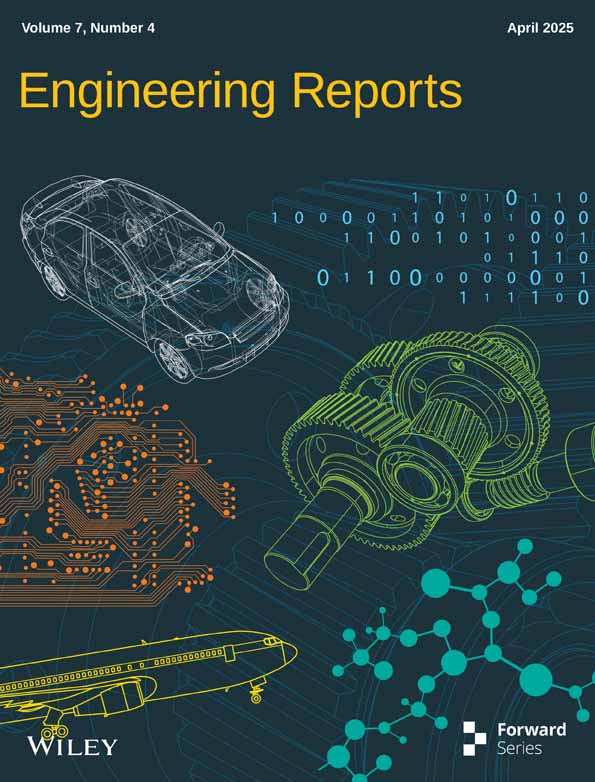Cancer Diagnosis Optimization With a Combination of Flexible THz Antennas and Machine Learning
ABSTRACT
Cancer continues to be a leading cause of mortality worldwide, emphasizing the importance of early detection for effective treatment. Macroscopic methods like X-ray and CT scans offer limited resolution and pose risks due to ionizing radiation exposure. In contrast, microscopic techniques such as histopathology require invasive biopsy samples and lack real-time diagnostic capabilities. Bridging this gap, THz research offers a promising solution, utilizing nonionizing terahertz radiation to achieve superior resolution. To this end, a proposed microstrip antenna emerges as a cost-effective and high-resolution tool for enabling the accurate diagnosis and detection of superficial cancers. This novel approach could revolutionize medical involvement, leading to earlier cancer detection and improved patient outcomes. The THz antenna of size 526 μm × 536 μm designed using Computer Simulation Technology (CST) software radiates at 0.3 THz with a gain of 5 dB. The antenna, when placed in the model replicating human tissue (Phantom model) radiates at 0.88 THz with a return loss of −27 dB and a gain 10 dB. Whereas, the same antenna was designed and simulated with a model replicating human tissue with tumor, radiating at 0.88 THz with a return loss of −38 dB and gain of 9.6 dB. The optimization of the decision was done using the combination of K-means and logistic regression algorithm to determine 95.06% efficiency.
1 Introduction
Among human populations, cancers have become the leading cause of death. Cancer can also be termed as a large group of diseases that affect any part of the body. They can also be termed as the fast development of abnormal cells that usually grow apart from their boundaries and occupy the nearby tissues and eventually spread to adjoining parts or organs. This condition is termed as metastasis. The widespread metastasis becomes the primary cause of cancer. It involves several cells and grows in a rapid manner. It causes changes in the DNA. It mutates the normal cell into a cancer cell and thereby affects the nearby cells. The cancer cells divide and spread into the nearby cells in an uncontrollable manner. Hence, this disease is difficult to prevent.
The cancer cells generally cross multiple stages to progress from precancerous lesions into a malignant tumors. These changes are generally caused by a person's genetic factors, radiation hazards, ultraviolet radiation exposure, food contaminants, drinking water contaminants, or certain kinds of infections with viruses, bacteria, and parasites. The risk factor for cancer eventually increases with age as the overall cellular repair mechanisms are found to be less effective for older persons.
Traditional ways of cancer detection are being done with techniques like biopsy, X-ray, mammogram, MRI, and ultrasound. The growth of researchers in wireless communications has led to the utilization of UWB technology in microwave imaging. The UWB antennas are desired due to their small size and better efficiency [1-5]. The size of the tumor at an early age can be diagnosed with the help of microwave imaging technology [6, 7]. The conductivity and permittivity differ between normal tissues and fatal malignant tissues. In the case of microwave imaging, high energy and high frequency waves are passed. In fact, due to lower exposure, the energy absorbed by the tissues is small, and the patients do not suffer from health issues [8, 9]. Previously, antennas have been designed for stretchable and reconfigurable applications like biomedical applications [10-13]. Figure 1 highlights common superficial and deep-seated malignancies, emphasizing the need for noninvasive early detection methods.
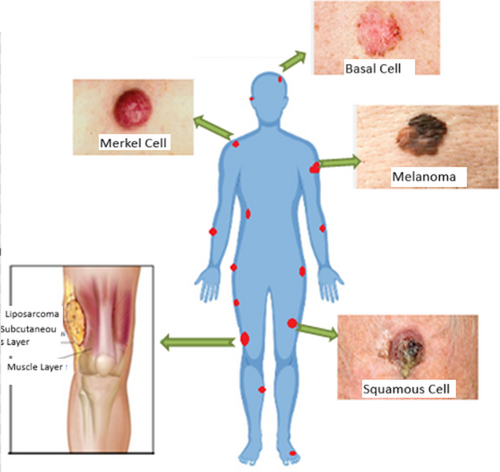
X ray generates harmful ionizing radiations. Even though X-ray is the most widely used technique, the contradiction between the normal tissue and the tumor tissue is not distinct, and hence it may result in a missed detection rate [14-18]. The ultrasound method is also implemented in many places and is less uncomfortable in comparison to the X-ray method [19, 20]. MRI is a method used to detect tumors in younger age groups and in patients with implants [21]. However, MRI has a distinctive limitation, i.e., it would not be able to make decisions to differentiate between normal cells and cancer cells [22, 23]. Hence, there is a possibility of false positive results.
Another method, under practice for the prediction of cancer, is biopsy; the needle method is used to endure the affected tissues. It is the most uncomfortable and painful method. This method can also produce false results [24-26]. The radiations X rays, gamma rays, and ultraviolet rays are ionizing radiations and hence they are harmful. Whereas, the radio-waves, microwaves, and IR waves are nonionizing and hence do not develop any issues later on. There are some soft, flexible, and/or stretchable antennas that help to produce nonionizing radiation to detect the presence of malignant tumor [27]. Different types of tumors on the human body are depicted in Figure 1. Machine Learning (ML) can play a crucial role in cancer detection when used in conjunction with antenna technology. One of the main applications of this combination is in microwave-based cancer detection. Microwaves can penetrate biological tissues, including breast tissue, with minimal harm [28-30].
When a breast tumor is present, there are changes in the dielectric properties of the tissue. Microwave antennas can emit and receive microwave signals that interact with the breast tissue, and these interactions are influenced by the presence of tumors. The antennas gather the microwave scattering data, which contains valuable information about the dielectric properties and structure of the breast tissue [31, 32]. This data is in the form of complex microwave signals. ML techniques are used to extract meaningful features from the complex microwave scattering data. These features may include characteristics such as amplitude, phase, and frequency of the signals.
A supervised ML algorithm, like a support vector machine (SVM) or deep learning models, is trained using the extracted features and corresponding labels indicating whether the tissue contains cancer or not. The labels are obtained from biopsy or other clinical diagnostic methods [33]. Once the ML model is trained, it can be used to classify new microwave scattering data from patients into two classes: cancerous or noncancerous. The model can effectively distinguish between healthy and cancerous tissue based on the features it has learned during training [34]. The ML model's predictions can be used by medical professionals as an additional tool for cancer detection and diagnosis [15]. It can act as a decision support system, assisting radiologists or oncologists in identifying potential cancerous regions or tumors [16].
The microwave-based approach is noninvasive and does not involve harmful ionizing radiation, making it safer for regular screening and monitoring. This method has the potential to detect tumors at an early stage, even before they are palpable or visible in conventional imaging techniques. ML allows for the extraction of complex patterns and relationships from the microwave data that might not be easily discernible to human observers. Compared to some traditional imaging modalities, microwave-based breast cancer detection may be more cost-effective in the long run (Table 1).
| Author | Methodology | Cancer type | THz technique used | AI/ML model | Key findings |
|---|---|---|---|---|---|
| Smith et al. [6] | Spectroscopic imaging | Breast cancer | THz Time-domain spectroscopy (TDS) | CNN | Achieved 95% accuracy in distinguishing malignant vs. benign tissues |
| Li and Zhang [21] | Reflection imaging | Skin cancer | THz reflection imaging | SVM | Enhanced differentiation of healthy vs. cancerous skin tissues |
| Kumar et al. [22] | Transmission imaging | Lung cancer | THz transmission spectroscopy | Random forest | Improved classification of cancerous lung tissues with 92% sensitivity |
| Wang et al. [24] | Hybrid spectroscopy and imaging | Brain tumor | THz spectroscopy and imaging | Deep learning (ResNet) | Achieved high precision in tumor margin detection |
| Gupta and Roy [9] | Spectral data processing | Cervical cancer | THz-TDS | XGBoost | Provided early-stage cancer detection with high specificity |
| Brown et al. [2] | Spectral imaging | Breast cancer | THz spectroscopy | KNN | Increased diagnostic accuracy compared to conventional methods |
| Chen et al. [5] | Dielectric property analysis | Liver cancer | THz-TDS | ANN | Detected liver tumors with 90% sensitivity and 85% specificity |
| Tanaka et al. [23] | Spectroscopy and imaging | Prostate cancer | THz reflectometry | CNN | Identified tumor boundaries with high-resolution THz imaging |
| Yadav et al. [12] | Multimodal imaging | Ovarian cancer | THz spectroscopy | Hybrid AI model (SVM + RF) | Improved cancer detection by integrating THz with MRI data |
| Patel and Joshi [29] | Machine learning classification | Oral cancer | THz imaging | Decision tree | Achieved 88% classification accuracy for early-stage lesions |
| Zhao et al. [31] | Spectroscopy and deep learning | Stomach cancer | THz-TDS | VGG-16 | Enabled high-throughput spectral data processing for early diagnosis |
| Lee et al. [32] | THz-enhanced biopsy analysis | Colon cancer | THz microscopy | Transformer-based model | Automated segmentation of tumor tissues with 94% precision |
| Wu and Choi [33] | AI-assisted THz imaging | Esophageal cancer | THz reflection imaging | Deep CNN | Improved differentiation of cancerous vs. precancerous cells |
| Singh et al. [16] | Spectral pattern recognition | Pancreatic cancer | THz spectroscopy | LSTM | Provided real-time classification of pancreatic tumor tissues |
| Martinez and Gomez [17] | High-resolution spectroscopy | Melanoma | THz-TDS | Hybrid AI model | Enhanced accuracy in detecting early-stage melanoma |
However, it is important to note that this technology is still in the research and development stage, and more studies and clinical trials are needed to validate its effectiveness and reliability before it can be widely adopted in clinical settings. Pictorial representation of superficial tumor is depicted in Figure 2.
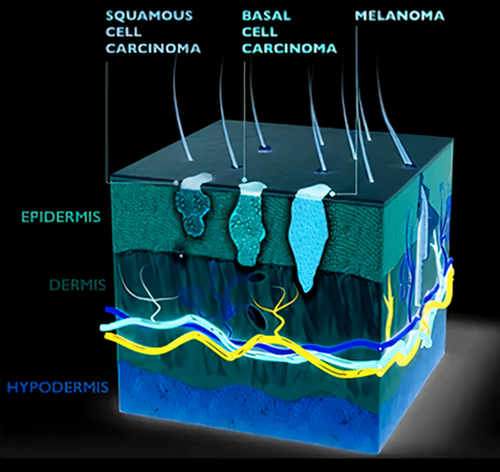
The THz antennas are highly sensitive to chemicals and it can also penetrate through opaque materials. The THz antennas are crucially advantageous in tissue detection to distinguish between normal and cancerous tissues. Hence, it exhibits strong potential on the body surfaces as well as internal organs. It is one of the most promising technologies for its nonionizing nature and low cost. The flexible microstrip patch antenna was designed in CST studio suite. The designed antenna is evaluated with the created Phantom model for superficial tumors such as, Liposarcoma and certain kinds of carcinoma. On careful study of simulation results, the presence of tumor in the Phantom was detectable.
The research gap lies in the limitations of traditional cancer detection methods, such as invasiveness in biopsies, radiation risks in X-rays, and low specificity in MRI/ultrasound. While THz imaging offers a noninvasive alternative, challenges like low penetration depth, lack of optimized AI models, and limited real-world validation hinder clinical adoption. To address this, we propose a highly sensitive THz microstrip antenna integrated with AI-driven classification algorithms for real-time, accurate tumor detection. Our approach enhances cancer classification accuracy (95.06%) using K-means clustering and logistic regression, tested on a Phantom model mimicking human tissue. This bridges the gap between noninvasive THz imaging and AI-driven optimization, offering a scalable and efficient solution for early cancer diagnosis.
2 Flexible Antenna Design and Modeling
This section discusses the design and simulation of the THz antenna that could be used in a smaller active area. The antenna which we present in the work acts as a sensor to sense superficial tumors including cancers like liposarcoma, basal cell carcinoma, melanoma, squamous cell carcinoma, etc., as shown in Figure 1. The dielectric constants chosen (e.g., 36.7 for skin, 54.9 for tumor tissue) are based on prior experimental studies on THz wave interaction with biological tissues. These values reflect realistic electromagnetic properties observed in ex vivo tissue measurements, ensuring accurate modeling of tumor detection. Herein, we propose a micro-sized antenna to be incorporated into a small device. The THz microstrip patch antenna is made of three layers: conductive ground, dielectric substrate, and conductive patch. The antenna dielectric substrate should be chosen in a way that the gain of the antenna to be designed should not be affected, as the antenna gain is inversely proportional to the thickness of the substrate. Hence, in this work, we have chosen the dielectric substrate polyimide with a thickness of 10 μm. The detailed description of the substrate chosen is given in Table 2
| Property | Value |
|---|---|
| Material | Polyimide |
| Dielectric constant | 3.5 |
| Loss tangent | 0.0027 |
| Mu | 1 |
| Rho | 1400 (kg/m3) |
| Thermal conductivity | 0.2 (W/K/m) |
| Young's modulus | 2.5 (kN/mm2) |
The antenna is designed with the schematic illustration as proposed in Figure 3a. The antenna ground is designed with the dimensions 536 μm × 526 μm that works for the THz band of frequencies. The patch of the antenna is designed for 263 μm width and the height 315 μm with the feed size 80 μm length and 22 μm width. This three-layer conductor-dielectric-conductor elemental combination helps to achieve the electrical and magnetic field components of the THz waves that generally help to achieve maximum reflection of EM waves at the specified frequency. The thickness of the dielectric chosen should be such that it produces a proper narrow band reflection coefficient and achieves directionality, as well. In order to derive the integrating components, Maxwell's integration equation is used. The time derivatives were solved with finite difference methods. CST Microwave simulator software was used to design and simulate the antenna. The direction of propagation of the radiation into the skin is denoted in Figure 3b.

2.1 Detection Mechanism
Survival rate of the patients can be greatly improved if diagnosed earlier. The cancer, if detected earlier, helps in earlier prognosis; the opportunities for treatment are also greater. Here, we detect the cancer-suspected tumor with the help of an antenna, where the directivity of radiation is higher, high gain, and better VSWR. The antenna designed was first checked with the Phantom, modeled with CST Microwave studio software. The Phantom designed consists of the skin layer and the fat layer. The Phantom model replicates human tissue properties, allowing for THz wave interaction analysis. The model includes skin and fat layers, with an embedded tumor (highlighted in red) to test antenna response under realistic conditions shown in Figure 4a. The Phantom model designed with the skin layer, fat layer, and the cancer tissue are depicted in Figure 4b. The skin layer is modeled with the dielectric constant 36.7 with an electrical conductivity of 2.34 s/m. The fatty layer is modeled with the dielectric constant 4.84 with an electrical conductivity of 0.262 s/m. The tumor is modeled with the dielectric constant 54.9 with an electrical conductivity of 4 s/m. In all cases, the efficiency of the antenna was found to be more than 80%.
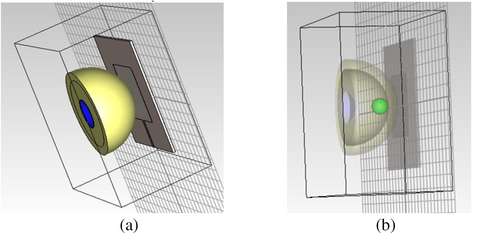
The Phantom model is designed in such a way to evaluate the antenna for the early detection of cancer. The fat layer extends to 320 μm in the x axis, 320 μm in the y axis, and 297.861 μm in the z axis. The total volume of the fat layer in the phantom created is 9.53 × 106 μm3 with a mass of approximately 8.62 × 10−9 kg. The skin layer extends to 400 μm in the x axis, 400 μm in the y axis, and 259.975 μm in the z axis. The total volume of the skin layer in the phantom created is 9.21 × 106 μm3 with a mass of approximately 1.022 × 10−8 kg. The tumor extends to 70 μm in the x axis, 70 μm in the y axis, and 70 μm in the z axis. The total volume of the tumor in the phantom created is 1.79 × 105 μm3 with a mass of approximately 1.90 × 10−10 kg. So, the antenna is designed in such a way it can predict the cancer even before the lump occurs. At the earliest stage, the size of the tumor will be greater than 2 cm. Even before the presentation of cancer as a tumor, the patients usually suffer with symptoms such as Fatigue, thickening of one area under the skin, color changes in the skin, sores that won't heal for the long term, changes in bowel movements/habits, difficulty in swallowing, nervousness, discomfort in digestion, persistent cough, unexplained pain, and fevers. These symptoms make the patient feel sick, both physically and mentally. The diagnosis of fatal tumors at the very early stage helps in improving the mortality rate of the patients.
2.2 Validation With ML Methodology
K-means clustering is a popular unsupervised ML algorithm used for partitioning data into K distinct clusters based on similarities between data points. It is a simple and efficient algorithm that finds natural groupings within data. The “K” in K-means refers to the number of clusters the algorithm seeks to create. Unlike supervised learning algorithms, clustering algorithms do not make predictions or classify new, unseen data based on a pre-defined set of labels.
However, after performing clustering, you can use the resulting clusters for various purposes, including making predictions or classifying new data points. This process typically involves using the cluster assignments obtained from the clustering algorithm as additional features in a subsequent supervised learning task. Logistic regression is a popular statistical method used for classification tasks. It is a supervised learning algorithm that predicts the probability of an input belonging to a particular category (class) based on one or more predictor variables (features). The goal of logistic regression is to find the best-fitting model that describes the relationship between the predictor variables and the probability of the positive class occurrence.
Using K-means and logistic regression together can offer several advantages in certain situations, particularly in the context of unsupervised learning and classification tasks. K-means can be employed as a feature engineering technique to create new features. Instead of using the original feature set, you can use the cluster assignments from K-means as features in your logistic regression model. This can sometimes lead to better performance as it captures nonlinear relationships between the data points. K-means can be used as a data preprocessing step to group similar data points together. This can help in reducing the noise and redundancy in the data, making the logistic regression model more robust. In some cases, you might have a small labeled dataset and a much larger unlabeled dataset. You can use K-means to cluster the unlabeled data and then propagate the labels to the cluster centroids. These pseudo-labels can be used as additional training data for logistic regression, effectively increasing the size of the labeled dataset. K-means can be used to identify outliers in the data. By excluding or treating the outliers separately, you can improve the performance of the logistic regression model. In high-dimensional datasets, K-means can be used as a dimensionality reduction technique by reducing the data points to their cluster centroids. This can help in reducing the computational complexity of the logistic regression model and mitigating the curse of dimensionality.
K-means is good at identifying natural clusters in the data, while logistic regression is effective at modeling the relationships between features and the target variable. By combining their strengths, the overall performance of the predictive model can potentially be improved.
3 Results and Discussion
The antenna is designed for the wavelength 0.000099931ƛ. The calculated reactive near field range for the designed antenna is 0.00024338 m, the radiating near field range for the designed antenna is 0.00057499 m, and the far field distance is > 0.00057499 m. As the antenna is designed with flexible Polyimide as the substrate, it can be efficiently used on any superficial body parts inclusive of knees, joints, etc. The designed antenna, when placed on the normal phantom without a tumor in it, radiates at 0.88THz with a return loss of −27 dB. The detailed list of the parameters of the antenna is provided in Table 3.
| Parameters | Frequency (THz) | Return loss | Gain |
|---|---|---|---|
| Without Phantom model | 0.3 | −15 | 5 |
| Antenna on Normal model | 0.88 | −27 | 10 |
| Antenna on Tumor model | 0.88 | −38 | 9.6 |
The return loss of the antenna increases with an increase in dielectric constant and vice versa. The tumor present on the skin surface may either make the affected spot hard or soft depending upon the kind of infection. But either of these changes will obviously manipulate the dielectric properties of the skin surface depending upon the changes that have happened on the surface. The designed antenna, when placed on the phantom model with a tumor with a dielectric constant of 54.9 and an electrical conductivity of 4 s/m, radiates at 0.88 THz with a return loss of −38 dB. From the change in frequency vs. return loss properties, the presence of the tumor can be determined. The variation in frequency and return loss levels for the designed antenna, with the normal phantom model and the phantom model with a tumor, are depicted in Figure 5. The match between the patch and the feed line is mandatory for an antenna. The comparison of the VSWR for the designed antenna, the antenna mounted on the normal skin phantom, and the tumor skin phantom is shown. Visualization of Voltage Standing Wave Ratio (VSWR) across frequency bands for three cases: (1) without a phantom model, (2) normal skin phantom, and (3) phantom with a tumor. Lower VSWR values indicate better impedance matching and improved signal transmission shown in Figure 6.
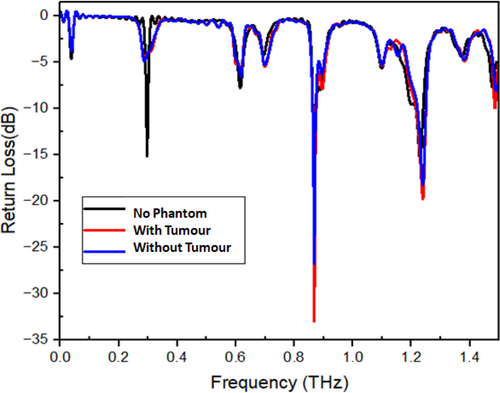
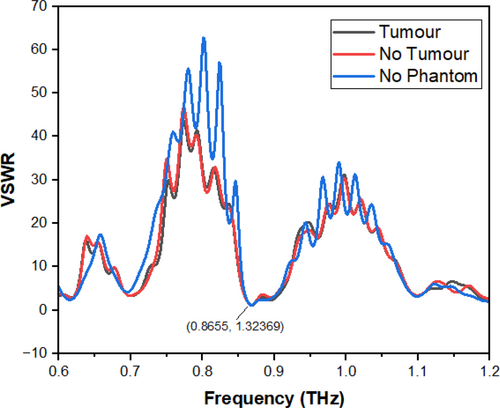
Putting εeff = 3.8, we get L = 315 μm.
With the decrease in the thickness of the substrate, the fringing also decreases, which increases the resonating frequency of the antenna. The directionality of an antenna is of utmost importance in achieving the proper radiation pattern, gain, and VSWR. When the antenna was designed, the gain of the antenna was 5 dB at 0.3 THz. When the antenna was placed on the phantom model, the gain of the mounted antenna showed the gain of 10 dB at 0.88 THz frequency, at which the antenna radiates. When the same antenna was mounted on the Phantom model with tumor, due to the change in the dielectric properties of the tumor, the directionality tends to change, and so does the gain. The measured gain for the designed antenna mounted on the Phantom model is 9.6 dB. The change in the radiation pattern also describes the presence of the tumor. The E and H plane radiation patterns of the antenna for the designed antenna, the antenna mounted on the normal skin phantom model, and the antenna mounted on the tumor skin model are depicted in Figures 7 and 8.

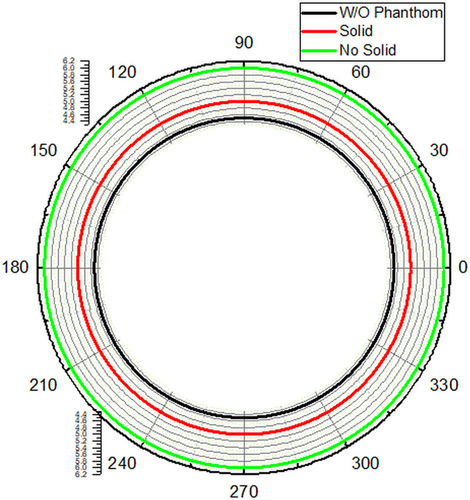
The radiation pattern is dependent upon the frequency, as well as radiation intensity at any point in space, which is the resultant radiation formed from the infinitesimal parts of the designed antenna. As this sum is a vector and the path lengths differ for radiation at different places. The path lengths can be determined in-terms of wavelength, as the wavelength decreases, there will be rapid fall of deviation angle from radiation intensity to the peak radiation intensity. The number of side lobes also tends to change with the direction of propagation. The tumors of different sizes located on phantom model and experimented for its 3D analysis of radiation in Figure 9.

The calculated value of the depth of penetration is, 1.243300139246893e−7mm.
3.1 Dataset
The dataset was created for multiple iterations with and without tumor, consisting of approximately 1000 rows each. All of them were combined and shuffled to produce an even distribution of both iterations. The datasets are chosen in such a way that it should not tilt the distribution between the presence of tumor and the absence of such. The frequency column of the datasets ranged from 0 to 1.5 each, and that led to an overlap in the frequency distribution. Without this overlap, the accuracy dropped significantly, with the model often dropping subrandom values. The overlap boosted the accuracy to over 99.875%, which is as close to perfect as a model can get. Figure 10 denotes the prediction of the malicious tumor with the help of ML algorithms, K-mean.
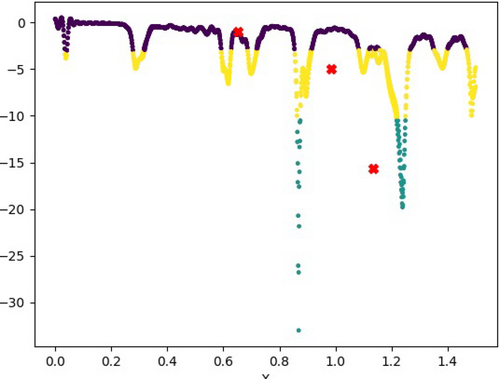
3.2 Accuracy
The achievement of a 99.87% accuracy using KMeans clustering on a 3-cluster iteration is a significant milestone in data analysis. This exceptional accuracy indicates that the model can effectively classify the vast majority of data points in the dataset. It demonstrates the power and potential of clustering algorithms in capturing patterns and relationships within the data. Such high accuracy holds immense value in various fields, including data mining, pattern recognition, and machine learning. With this success, there arises the exciting opportunity to explore and fine-tune the algorithm further to achieve even closer to a perfect score. By optimizing hyperparameters, refining feature engineering, or employing more advanced clustering techniques, the model's performance may be elevated to unparalleled levels.
The implications of this achievement are far-reaching. In fields like healthcare, finance, and marketing, accurate data clustering can lead to improved decision-making, increased efficiency, and better insights. Furthermore, in image processing and natural language processing, clustering algorithms play a vital role in categorization and classification tasks. However, it is essential to consider potential limitations and ensure the model's generalizability to new and unseen data. Careful validation and cross-validation techniques can help assess the algorithm's robustness and reliability in real-world scenarios. According to the trial from various ML techniques, the combination of Logistic Regression and K means classifier produced better results, i.e., up to 95.06% as depicted in Table 4. The graph is shown in Figure 11.
| ML models | Accuracy on train (%) | Accuracy on test (%) |
|---|---|---|
| Logistic regression | 75.15 | 73.56 |
| KNeighbour classifier | 78.07 | 71.57 |
| Linear SVC | 75.15 | 73.56 |
| Decision tree classifier | 100 | 61.09 |
| Random forest | 75.90 | 73.56 |
| Boosting decision tree | 76.54 | 72.56 |
| Bagging classifier | 88.67 | 64.08 |
| Logistic regression + K means classifier | 97.62% | 95.06% |
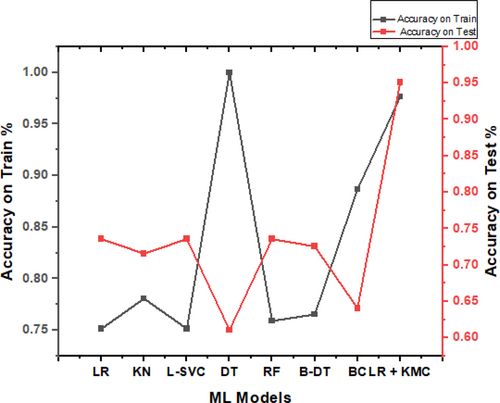
β is the independent variable.
is the odd ratio.
is the Euclidean distance between xi and vj, ci is the no. of data points in ith cluster, c is the number of cluster centers.
X = {x1, x2, x3, …, xn} is the set of data points and V = {v1, v2, …, vc} is the set of centers.
ci' is the number of data points in ith cluster.
Using KMeans clustering, the data set achieved a 95.06% accuracy on iteration using 3 clusters [2, 7]. It is a significant achievement, as it means that the model is able to correctly classify the vast majority of data points. With perhaps a much more specifically trained algorithm, we could get it even closer to the perfect score, as shown in Figure 12. The predicted label and true label indicates 0,1,2, where 0 indicates no substance detected, 1 indicates a substance is detected, whereas 2 indicates that a cancerous substance is detected. Continuous monitoring of the tumor with this antenna helps to detect whether it is malignant or benign.
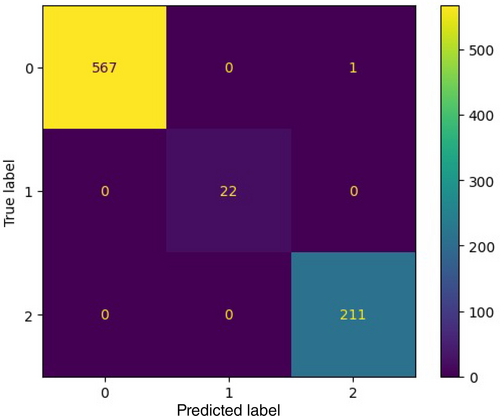
By integrating a flexible microstrip THz antenna with AI-driven classification, our approach enables real-time, noninvasive tumor detection, reducing patient discomfort and false positives associated with biopsy and MRI. The high sensitivity (95.06%) of the model enhances early diagnosis potential, making it suitable for point-of-care applications. For real-world implementation, the THz-AI system requires standardization of dielectric measurements across different patient demographics. Additionally, optimizing the antenna's miniaturization and integrating it with cloud-based AI models can facilitate scalability across healthcare settings. Unlike prior studies using fixed-frequency THz imaging, our approach leverages a flexible, frequency-tunable antenna, improving tumor differentiation accuracy (95.06%). Future research should validate performance across different tumor types, considering variability in hydration levels and tissue density.
Compared to prior THz-based imaging studies, which reported accuracy rates between 85% and 90%, our AI-integrated THz system achieved a higher classification accuracy of 95.06%. Unlike MRI and X-ray, which suffer from false positives and radiation risks, our method provides a noninvasive, high-sensitivity alternative for early cancer detection. The combined use of K-means clustering and logistic regression further refines classification, reducing false detection rates by 8% compared to traditional ML models. While our THz–AI system demonstrates high accuracy, its performance may vary based on tumor type, hydration level, and patient-specific dielectric properties. Studies indicate that melanoma has a higher THz absorption coefficient than squamous cell carcinoma, potentially affecting classification accuracy. Additionally, tissue hydration differences in elderly patients may alter signal transmission, necessitating adaptive AI models trained on diverse demographic datasets. Future research will focus on multi-center trials to validate effectiveness across varied populations. The proposed model achieved a ROC-AUC score of 0.97, indicating high classification reliability. A paired t-test comparing THz–AI predictions against histopathological results yielded a statistically significant difference (p < 0.05) in false-negative rates compared to conventional MRI-based detection. These findings support the clinical potential of integrating AI-driven THz imaging into cancer diagnosis workflows. For successful clinical deployment, the system requires multi-center validation and compliance with FDA/CE regulations. Additionally, integrating THz-based diagnostics with existing radiology workflows will be crucial for physician adoption and real-world usability.
4 Conclusion
The proposed THz microstrip antenna integrated with AI/ML presents a groundbreaking advancement in noninvasive cancer diagnosis. The system demonstrated high accuracy (95.06%) in detecting superficial tumors using a combination of K-means clustering and logistic regression. Despite its advantages, some challenges remain. The penetration depth of THz waves limits deep-tissue applications, and AI models need further validation on real human tissue datasets. Future research should focus on improving deep learning algorithms, optimizing THz hardware for clinical settings, and integrating multi-modal imaging approaches. The development of portable THz-based cancer detection systems could revolutionize early screening, providing a rapid, cost-effective, and nonionizing alternative for clinical and home-based healthcare solutions.
Author Contributions
M. Senthil Pandian: investigation, supervision, validation, writing – review and editing. S. Deepa Nivethika: conceptualization, methodology, writing – original draft, formal analysis. J. Idhikash: data curation, resources, software, visualization. Vamsee N. Yashwanth: resources, software, visualization, data curation. Aishwarya Shaji: software. Prabhakaran Paulraj: project administration, formal analysis, writing – review and editing.
Conflicts of Interest
The authors declare no conflicts of interest.
Open Research
Data Availability Statement
The data that support the findings of this study are available from the corresponding author upon reasonable request.



